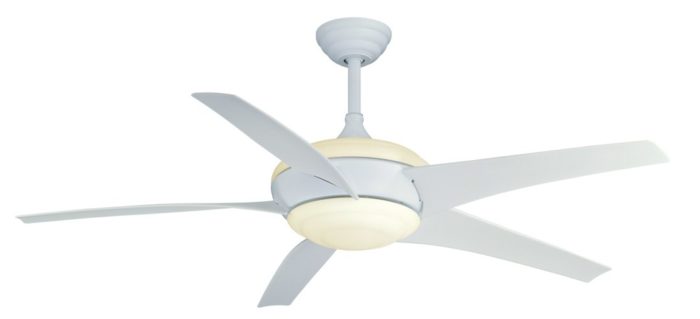
Image Credit: Gossamer Wind
When I was a young backpacker traveling through India, Sri Lanka, and Thailand in the 1970s, I couldn’t afford air-conditioned hotels or restaurants. In these tropical conditions, I became quite accustomed to the benefits of Casablanca-style fans.
Although a fan can’t lower the temperature of the air, it can make people feel cooler. Moving air accelerates the rate at which perspiration evaporates from your skin. The evaporation process requires heat, so increased evaporation means that more heat is leaving your body.
Moving air also removes heat from your body by convection — at least as long as the air temperature is below 100°F or so. Once the air temperature significantly exceeds your body temperature, however, fans tend to raise rather than reduce your body temperature (unless you are very wet).
Fans use electricity and their motors give off heat, so it’s important to use them sparingly and appropriately.
Ceiling Fan Tips
- Buy an efficient model — ideally a Gossamer Wind fan. (Emerson Climate Technologies is the best current source for the Gossamer fan; Emerson sells the fan under the Midway Eco brand (model CF955BS).
- Choose a fan with a long enough down-rod. A ceiling fan works best when it’s located 7 or 8 feet above the floor.
- To make it easier to turn off the fan when you leave the room, the fan should be controlled by a wall switch, not a pull chain.
- Remember that ceiling fans make the most sense in a house without air conditioning; if your house has AC, resist the temptation to turn on the cooling.
- If no one is in the room, turn off the fan.
- Once the air temperature exceeds 100°F, turn off the fan and take a shower.
How much energy do ceiling fans use?
Ceiling fan energy use varies by…
Weekly Newsletter
Get building science and energy efficiency advice, plus special offers, in your inbox.

This article is only available to GBA Prime Members
Sign up for a free trial and get instant access to this article as well as GBA’s complete library of premium articles and construction details.
Start Free TrialAlready a member? Log in





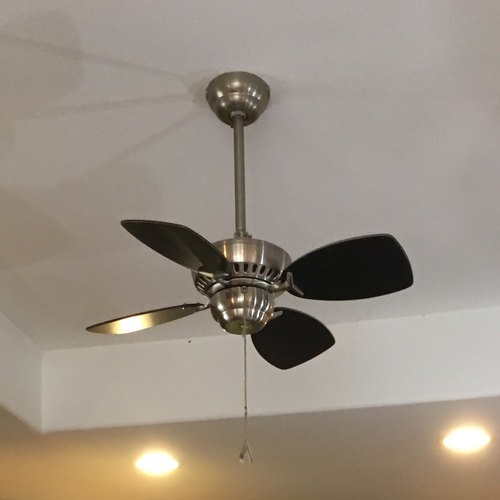
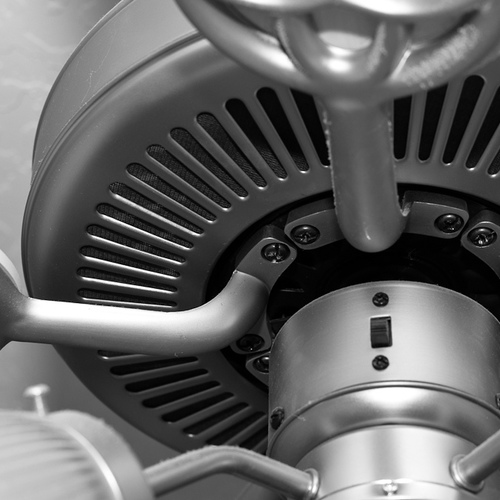
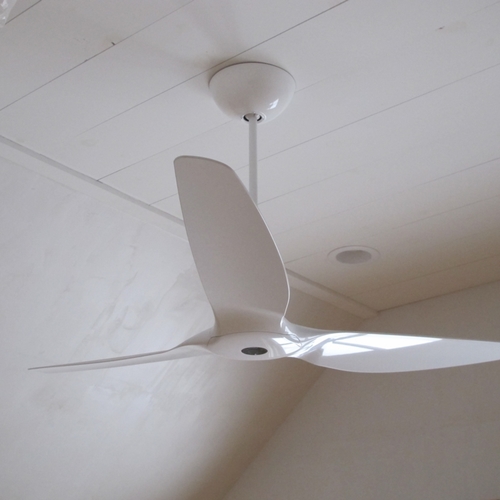
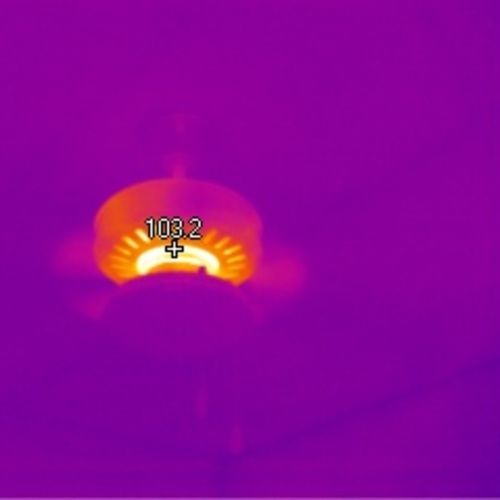






24 Comments
What about humidity?
We like to run our ceiling fans and whole house fan during the Spring and Fall, but Summer is so humid that the AC makes us most comfortable. We've tried running dehumidifiers, but they put out a lot of heat and I'm guessing use substantial energy to run (although not as substantial as AC). Are there reliable solutions for mixed climates that don't involve both AC and lots of fans? We're in Nebraska.
Response to Michael
Michael,
There is no low-energy-use method of lowering the indoor humidity, unfortunately.
low-energy Air Control "method"
Michael,
An Energy Audit might be useful.
Have you considered measuring and improving the air tightness and pressure balance of your home?
Most "whole house fans" are far from air tight.
ceiling fans used for night flushing in cold climate, worth it?
I have seen designs for single family homes in a cold climate (Minnesota) that pair a ceiling fan with operable skylights in cathedral ceilings as a means of night flushing.
I live an old leaky under insulated 2 story single family home without air conditioning and do a form of night flushing during the summer. I can imagine if I had an opening in a cathedral ceiling and could flush hot stratified air upward and outward this would be more effective than flushing sideways out second floor windows. (Can ceiling fans be set to push air upward?)
One local designer who did the ceiling fan/ operable skylight configuration in his own above code insulated retrofit home (tightness not known) noted after living in the house for a winter that he planned to rig up some way to insulated the skylight because he was concerned about heat loss in the winter. I believe he came to this conclusion by sensing the radiant heat loss when occupying the second floor rather than seeing an energy penalty based on comparing energy bills to expected performance.
The question is in a cold climate would it be advisable not to night flush using a ceiling fan + operable skylight because of the heat loss from the skylight in the winter?
night flushing
I have installed numerous operable skylights over the years, and most of my clients (including my parents) appreciate the versatility of them (I’m in the Mid-Atlantic). On the Velux models, you can get the skylights with operable cellular shading, which can be closed while the skylight is open, allowing for more venting with less interior heat gain. In the winter, there is certainly a compromise with the reduction of R value in the ceiling, as well as the increase in air leakage potential, but there is quantifiable solar heat gain which can certainly offset this deficiency. I don’t know if any building science professionals have measured and quantified any of this.
I know that this may not answer your questions, but I also might add that numerous green building experts are by no means in agreement on the role of skylights. Some love them, and some loath them.
And as far as ceiling fans go, certainly it's us people that benefit the most from the circulation that fans provide, but ceiling fans seem to move air around in homes in a more "natural" way than a bunch of 50 square inch louvers do. I know that in my old, highly unbalanced and underinsulated home, the fans make a huge difference, esp. in the bedrooms at night. The t-stat is set lower because of this.
Hope this helps.
Matt
response to matt
Thanks for sharing the positive feedback your clients have had with the operable skylights
2nd floor window better than operable skylight
I just took out four thermal pane partially-openable skylights, and use two window exhaust fans on the second story.
We live in the mountains in northern New Mexico, do not have air-conditioning, and just installed four ceiling fans. (I wish I had this info on the Gossamer Wind fan a month ago.)
The skylights I just took out created a horrible heat gain in the summer, and a significant heat loss in the winter. Most people are extremely unlikely to get a net heat gain from a skylight in the winter since the sun is so low in the sky. I would be interested in hearing the reasons from a green building expert who loves skylights!
I have two $20 window exhaust fans on second story windows that work just great. My wife and kids complain that the house is too cold in the morning. Depending on how cool the night is, the temperature in the house in the morning can get down to 65-68 degrees F. Even though the fans consume some energy, they are much more cost effective than spending lots of money to install operable skylights.
Personal experience...
For years living in Houston TX, our house had AC, but we kept it at 85 while there (I would come in from an office job and turn it 'down' to 82. We used ceiling fans, to help us feel more comfortable. The 'destratification' issue in the summer doesn't hold much water since 'warm air rises', the cooler air is nearer the floor. But the fan keeps it fairly homogenized in our house in the summer.
Winter, since hot air rises, if not using ceiling fans a little bit, the air does stratify, especially noticeable in places with faulted ceilings. Our house did this. And in friends houses with large 'lofts' up stairs, without 'mixing the air' it can be considerably warmer up stairs.
Also 'dressing the part' can help. Fewer/lighter clothes in the summer or warmer days, and vice versa for the cooler periods.
And yes, we did shut of the fans if we weren't going to be in the room for a while, just like the lights (most were controlled by a switch on the wall right with the lights!)
We also use fans to exhaust the house in the spring/fall (we even considered putting in whole house exhaust fans ... they help too). Just about anything to reduce the number of days we had to run the air.
No, I don't have 'studies', and we left Houston 5 years ago, so our old utility bills are gone to show year to year comparisons. But most folks do heat and air to be comfortable. Just do your best to be comfortable warmer in the summer, and cooler in the winter!
For reference, we considered the year 1 month spring, 8 months summer, 1 month fall, and 2 months winter. It all varied year by year... Basically we heated 2 months of the year and did AC 8 months. So it was more of an issue for us. And if you have ever been in Houston without AC in August, you can understand why AC is not considered a luxury there - the heat is OK, but add the humidity and it is stifling.
Keeping Cool w/ Fans
I recently lived in a house that had air conditioning, but didn't use it. The reason is b/c I was able to cool my house w/ using only fans. I opened 1 north facing window in the basement and put a window fan blowing air into the house. Next, I went upstairs into the attic and opened 1 west facing window and placed another fan blowing air out of the house. My theory was that the cool air would be drawn from the basement and travel through the house and blow the warmer air out the upstairs window. I stayed very comfortable even during the "Dog Days". I do have to give a lot of credit to the orientation of the house and to a lot of deciduous trees giving me shade, but I am a firm believer that ceiling fans can help cool a house.
Ceiling fans
I live in South Florida and ceilings fans are used in all homes. We do raise the thermostat temperature and use the fan while in the room, however teenagers never turned them off that is true. So all our fans, especially the bedrooms, are on 12 hour timers. At nigh our thermostat is set to 80 and we set the bedroom ceiling fan timer to about 8 hours. This is the best compromised I have found. Our a/c electrical bills are very high in comparison to northern states, about 1500 or more for 2200 sq ft homes, though poor insulation is a trait in many block or stick built Florida homes.
When in the family
Fan controls are a problem
Thanks for the article.
I suspect that some people let their fans run so long because the pull-chain controls are a hassle. It is easier to just leave it on than it is to pull the chain 12 times trying to figure out if it is on or off (even though cheap fans solve this problem with a handy buzzing sound). They also are probably only inclined to change the setting when they are noticably uncomfortable.
I wonder if wall switches with speed controls make people more likely to turn the fan off when they leave the room. Occupancy sensors may be a bit of overkill, and, of course, would have to be aimed so that the movement of the fan doesn't make the fan think there is somebody in the room, thus continuing to run the fan :)
In the end, widespread education like this article is probably the best solution.
winter experiment is invalid
I believe your proposed experiment to run the ceiling fan (in reverse) in the winter to see if there is a difference in comfort level is invalid. The belief is not that running it will make you more comfortable, but that it will reduce your energy usage! The heating system is going to make the temperature the same at the height of your thermostat in either case. The question is how much energy is needed to achieve this. Warmer air will tend to collect near the ceiling without the fan on and this can be a significant difference if you have high ceilings , e.g. cathedral. The fan will tend to keep the distrubution of air temps more even throughout the space. In a room with a tall ceiling, this can result in slightly low AVERAGE temp, and therefore less heat loss, for the same temp at the thermostat/"comfort" level.
thanks for the advice
I was one of "those" people who leave ceiling fans on 24/7. I didn't realize that it wasn't helping. Thanks for the learning!
Ceiling Fan In Article Not Available To Purchase
I followed the link in the article for purchase information on the Gossamer Wind ceiling fan and was directed to Home Depot's web site. There it showed the fan but it is not available for purchase. I called Home Depot and they confirmed the item is not for sale. I called my local Home Depot to see if they could special order the fan and was told no.
At last - vindication!
So glad to hear the "turn it off policy - Years ago in the 90's I fought this issue w/a roommate renting a room from me - she insisted on leaving the fan on all day, when she wasn't there. I said it wasted electricity and actually heated the air, but I was wrong about the mechanics of how. I was just thinking of molecules moving around causing increased energy = heat.....o.k. so I was sort of right. :-O
certain conditions...
Living in Quebec in a cathedral roofed main living space, with one ceiling fan and Electric baseboard heaters around the perimeter of the room.
In these conditions I find the fan improves comfort levels quite dramatically in the winter. Our baseboards provide little to no convection currents so the air would remain quite stagnant and stratified in this tall space. The ceiling fan IMO helps on both these counts.
We also have no AC and thankfully our dramatic overhangs keep the heat down, and again the fan operates only when we feel the need. : ) Thanks for great article Martin.
Another erason to run a ceiling fan
I have a well-insulated cottage in Maine that is heated minimally in the winter to 40-45F. Leaving the ceiling fan on low speed helps to circulate heated air in the cottage and prevent cold spots that could potentially result in damage from freezing.
Excellent post on keeping
Excellent post on keeping homes cool without AC. As explained in your post, insulation products are an essential ingredient to quality build construction projects. A great resource to start with is the McGraw Hill exterior insulation directory. I work for McGraw hill and can vouch that I have never seen a more useful directory full of top quality solutions. You can get lists of products, manufacturers, detailed information, images, and even download CAD details from their site. Hope this helps.
Response to John Porriello
John,
You're right -- the Gossamer Wind Web site hasn't been updated for a while.
For anyone confused about where to get a Gossamer Wind ceiling fan, read the first bullet in the sidebar above -- the box with the "Ceiling Fan Tips" headline.
Here is advice from Danny Parker, the developer of the Gossamer Wind fan, on options for buying a model based on his design:
"Tien Lowe, I and the university met on Wednesday to discuss the Gossamer ceiling fan line and we have quite good news:
1) The Windward III can be purchased direct from King of Fans. The contact person is Rabbit Chan a Sue:
Rabbit Chan-A-Sue
Executive Assistant to Mr. Lowe
King of Fans, Inc.
1951 NW 22nd Street
Ft. Lauderdale, FL 33311
PH: 954.556.4054
FX: 954.484.7587
E-Mail: [email protected]
2) The Gossamer Industrial is currently available widely at Home Depot, both in stores and online:
http://www.homedepot.com/webapp/wcs/stores/servlet/ProductDisplay?storeId=10051&langId=-1&catalogId=10053&productId=100015874&N=502796+90401+4294965499
3) Our Windward II with a new highly efficient DC motor is available currently from Emerson as the Eco fan-- most efficient ceiling fan currently available:
http://www.emersonfans.com/Pages/Fan.aspx?Fan=Midway+Eco&Item=CF955WW
4) We have another Gossamer Wind based product available from Home Depot that is designated the 68-ich Hampton Bay Altura. This is a large fan with unsurpassed air moving efficiency at low speed. As it operates a lower rotational speed, it also is exceedingly quiet.
http://www.homedepot.com/webapp/wcs/stores/servlet/ProductDisplay?storeId=10051&productId=100627456&langId=-1&catalogId=10053&ci_sku=100627456&ci_src=14110944&cm_mmc=shopping-_-googlebase-_-D27X-_-100627456&locStoreNum=6367&marketID=3
We are working to adapt this product to improve the blade shape somewhat and to eventually mate it to a DC motor, which should result in the most energy efficient fans available anywhere-- even superior to our earlier designs.
Hope this helps. I'll be calling you shortly."
Danny Parker
mixing for night flushing
Thanks for the article. I use two fans for night flushing. First is a squirrel cage exhaust fan in a kitchen window at the opposite end of the living space from the bedroom. The bedroom has a small fan and the only open windows for air to come into the living space.
Whether the small fan is cooling people directly or not it mixes the fresh cool air into the room and helps the exhaust fan be effective at cooling the space. This has been my strategy for living without A/C.
DeStratification
The Shape of “Ceiling Fans" has changed - http://www.theAirPear.com - Destratification does work ! And saves Energy - 35,000 installed fans worldwide demonstrate it - Multiple studies support it (http://www.theairpear.com/casestudies.html) Heating and Cooling Savings - increased comfort - and reduced maintenance cycles - Works in 8 ft ceilings and works better at 100 ft - Classical rule; buildings stratify at about 1/2° F for every vertical foot of interior space. All the heat above your head is wasted BTU, BTU that someone paid for and most of it is escaping through the roof. In the summer – Moving air allows for higher temp set points and instead of stratified “Cooling” we get even temps and reduced electrical consumption, Trapped ceiling heat acts as an infrared source, making people feel warmer than the air temp – often resulting in the desire to lower thermostat settings resulting in using more electricity. People are more comfortable in 75° F moving air than in 72° F still air. Consumer Reports - Old School Tech. [email protected]
Our Windward II Fans Lower our AC Usage
We have two Windward II Fans bought at Home Depot several years ago that came with Hampton Bay remote controls that also have a temperature setting. Having a temperature control allows us to set the bedroom fan, for example, to turn off when the room temperature drops below 75 degrees. So, it's practical to retire to bed on hot evenings using only the fan because if the room temperature drops to where it's comfortable, the fan shuts off. These fans (plus a retractable south-facing awning -- remember awnings?) have almost eliminated all use of AC in our Western Washington home except for three or four days a year when evening temperatures remain stifling high. These fans can clear out the hot air in our great room (cathedral ceiling) in minutes so there's no need to leave them running when a room is empty. They run silently and keep things comfortable when set on their lowest speed. Right now, we're staying in a Hawaiian ohana equipped with a typical ceiling fan, like most for sale in Home Depot, etc., that is just about useless. Really. At full speed there is barely any air movement. With our Windward II, running it on high speed will clear the tables and counters of anything not nailed down and flush out the hot air in minutes. It's silly to talk about fans and cooling efficiency when 99% of fans on the market are merely decorative and not designed to do anything but spin. I don't know why anyone would install them. If you want to save on AC, then Gossamer is the way to go. Forget about anything else. These fans will reduce your energy costs.
Whadabout them thar Big Ass Fans?
http://www.bigassfans.com/the_fans
Don`t have one myself .... but ... as a taking point.......... I might just buy one.
Fans worked for us...
In Houston we used fans in an AC'd house. Talking with our HVAC service guy, he said there are people in my area that spent $700+ per month in electricity and our highest (in a smaller house) rarely topped $200 in the worst of times. We used fans in the summer and winter just for 'comfort control'. In the summer it allowed us to stay comfortable with the temp set at 82 or 83 inside when others turned their AC down to 76 and their never turned off. We did put in 'attic blanket' over our blown in fiberglass insulation, tightened up the duct work, etc. But we saw those as investments where others would rather just turn down the AC a bit more.
BigAssFans.com ... they are cool. My wife wishes she had a couple for the horse arena!
Back to the house... We did use the fans (reversed, on low) in the winter too, occasionally but not 'religously'. In an all electric except heat home, we did watch our electric usage more than most, but we were rewarded for the effort most of the year.
In Houston, heat runs basically 3 months of the year, and AC runs at least 8, sometimes 10 months. All these numbers were reports from early/mid 2000's, about 7 years ago now, when we left that area.
Log in or become a member to post a comment.
Sign up Log in